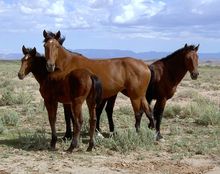The Interior Department’s Bureau of Land Management (BLM) is poised to continue its costly, cruel and inhumane helicopter roundups of wild horses and burros in 2014, according to contracts timidly released at 4:33 PM ET last Friday, January 31.

Free-roaming wild horses in Arizona desert
The Bureau of Land Management is poised to continue its costly, cruel and inhumane helicopter roundups of wild horses and burros in 2014, according to contracts timidly released at 4:33 PM ET last Friday, January 31.
© 2014 by Kersti Nebelsiek
The two $6 million contracts secure the services of helicopter companies for wild horse and burro roundups, despite findings of a National Academy of Sciences (NAS) review that called for cost-effective alternatives to “continuing to remove horses to long-term holding facilities.” The agency has presently rounded up and removed so many wild horses from public lands in the West that it now stockpiles 50,000 of them in holding facilities. The number of wild horses held in captivity now exceeds the number (fewer than 35,000) left on the range.
In June 2013, the NAS issued a scathing report on the BLM's Wild Horse and Burro Program, which found that the "continuation of 'business as usual' practices will be expensive and unproductive for BLM and the public it serves."
The report goes on to call for the increased use of alternatives - such as fertility control - to manage wild horses on the range thus reducing the need for helicopter roundups.
"While the agency allocates millions more for helicopters, it is scaling back on proven fertility control vaccines that have been recommended by the NAS and are widely accepted by the public," Suzanne Roy, director of the American Wild Horse Preservation Campaign (AWHPC).
"The BLM is acting as though it has no solutions to manage wild horses on the range when, in reality, humane and cost-effective methods are available as the NAS has confirmed. At the same time the agency is planning to proceeding with extreme surgical sterilization methods that threaten the health of individual wild horses and the viability of remaining free-roaming herds."
One of those methods is spaying mares (female horses), which the NAS specifically warned against, stating that "the possibility that ovariectomy [spaying] may be followed by prolonged bleeding or peritoneal infection makes it inadvisable for field application."
In June 2013, 30 members of Congress signed a letter to Interior Secretary Sally Jewell urging her to embrace the NAS reforms to make the BLM's program more sustainable fiscally and logistically.
The BLM paid over $1 million for the NAS study, which found among other things:
- Tools already exist for BLM to address many challenges.
- Removals are likely to keep the population at a size that maximizes population growth rate, which in turn maximizes the number of animals that must be removed and processed through holding facilities.
- Considering all the current options, [porcine zona pellucida (PZP) vaccines and GonaCon™ vaccine for females and chemical vasectomy for males] either alone or in combination, offer the most acceptable alternative to removing animals for managing population numbers.
Additional information on the NAS study is available here.
The American Wild Horse Preservation Campaign (AWHPC) is a coalition of more than 60 horse advocacy, public interest, and conservation organizations dedicated to preserving the American wild horse in viable, free-roaming herds for generations to come, as part of our national heritage. AWHPC’s founding organization, Return to Freedom (RTF), a national non-profit dedicated to wild horse preservation through sanctuary, education and conservation, also operates the American Wild Horse Sanctuary in Lompoc, CA.
